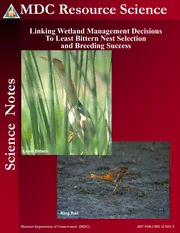
Science Notes 2017, Volume 12, Number 5 PDF
Preview Science Notes 2017, Volume 12, Number 5
MDC Resource Science Linking Wetland Management Decisions To Least Bittern Nest Selection and Breeding Success s e t o N e c n e Least Bittern i c S King Rail Missouri Department of Conservation (MDC) 2017 VOLUME 12 NO. 5 Linking Wetland Management Decisions to Least Bittern Nest Selection and Breeding Success on Public Wetlands in Missouri By: Evan B. Hill, University of Missouri; Elisabeth B. Webb, USGS Missouri Cooperative Fish and Wildlife Research Unit and Doreen C. Mengel, Missouri Department of Conservation Background Information: Several secretive marsh bird Management Implications: This project demonstrated (SMB) species are both migrants and breeders in Missouri. that least bitterns are nesting in some of Missouri’s public The degree to which individual birds stay to nest in Missouri wetlands and identified important habitat characteristics. versus continuing north to breed is unknown and has resulted Least bitterns selected wetlands and nest sites that in uncertainty regarding the role of Missouri’s wetlands for included habitat characteristics positively associated with this group of birds. One key uncertainty identified by many nest success: water depth and emergent vegetation (both Department wetland managers is whether their management height and coverage). Thus, providing water depths of 50 actions are emulating wetland processes that enable SMBs -80 cm in wetlands with >50% emergent vegetation to fulfill their life history requirements while in Missouri. For through the duration of least bittern nesting period (mid- managers to ensure successful outcomes for individuals that July) will likely maximize least bittern nesting efforts and use Missouri either as a stopover location or a nesting overall nest success. destination, they must know not only the key wetland Considerable uncertainty remains as to why least bitterns conditions required by the birds but also the timing of when choose to nest in Missouri or migrate northward; these resources are needed. Our objective was to determine additional investigation to determine specific factors (e.g., the effects of hydrologic management and habitat role of wetland food resources, role of wetlands on characteristics on SMB nest site selection and daily nest private land) that may influence these choices would survival at two spatial scales: the individual wetland and the further inform management decisions targeted toward nest point (area within 50 m of nest). SMBs. Methods and Results: We conducted a two year occupancy study (2013-2014) that included six rounds of repeated call-back surveys to detect the presence of five SMB species (Virginia rail (Rallus limicola), sora (Porzana carolina), King rail (R. elegans), least bittern (Ixobrychus exilis) and American bittern (Botaurus lentiginosus)) during spring and summer (April-July) on 107 wetland units across 8 Conservation Areas and 4 National Wildlife Refuges throughout Missouri. We also collected habitat measurements at study wetlands, surveyed wetlands for nesting activity and monitored nests for survival. Wetlands selected for nest searches where those 1) in which least bittern or King rail were detected at least once during call- back surveys and 2) that were inundated during the final round of occupancy surveys. Analyses only involved least bittern because no King rail nests were found. See Hill (2015) for more details on study methods, results and discussion. Over the 2 year study period, we searched 34 wetlands for signs of King rail or least bittern nesting activity and monitored 71 least bittern nests located in 8 wetlands. All least bittern nests were located in persistent emergent vegetation (cattail or bulrush) and 65% of nests fledged at least one chick. Least bittern selected wetlands with an average water Figure 1. Relationship between average wetland water depth and probability depth of ≥50 cm (Figure 1.top) and >50% emergent a wetland is selected for least bittern nesting (top) and average water depth vegetation coverage to establish nests. Within a wetland, within 50 m of a least bittern nest and daily nest survival (DSR) probability nests were generally located along or near the interface (bottom). Water depths of 50-80 cm generally predicted nest survival. between tall, emergent vegetation and open water with average water depth of ≥50 cm. Citation: Least bittern daily nest survival was positively associated Hill, E.B. 2015. Linking wetland management decisions to secretive marsh with water depth at the nest site, with water depths of 50- bird habitat use during spring migration and summer breeding on public wetlands in Missouri. M.S. Thesis. University of Missouri – 80 cm generally predicting nest survival (Figure 1bottom). Columbia. 117 pp+app. For more information, contact: Keywords: rails, sora, Virginia rail, king rail, American bit- Missouri Department of Conservation tern, least bittern, nesting, ecology, wetland, water-level Resource Science Division manipulation 2901 West Truman Blvd. Jefferson City, MO 65109 573-751-4115 2017 VOLUME 12 NO. 5 [email protected]
